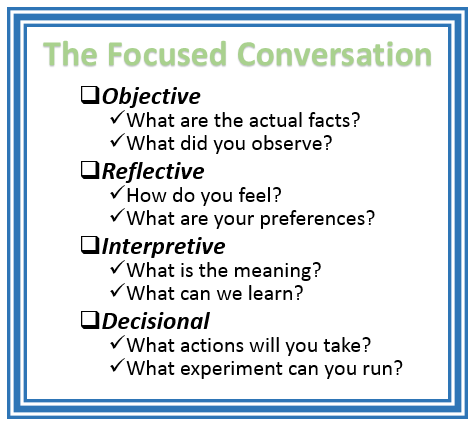The Responsibility Process™ is a practice (some may argue it’s more or less than a practice) that helps us move towards more self-mastery. Being able to facilitate ourselves is all about emotional intelligence – our ability to recognize and react appropriately in the moment to our emotions.
Management
Is Your Training Amazing & Engaging? Or Does it Smell?
I find many things puzzling. One that is puzzling, frustrating, and annoying is how people continue to use outdated methods to train.
Agile Coaching Framework Visual Walk-through (Part 3)
Learning the different approaches an agile coach may take can be challenging without experiencing them. My preference when training people is to run exercises to help them experience the various approaches to agile coaching. Most recently, I had the opportunity to run one with a diverse group of people at a recent conference. We got into some amazing discussions! I also had a chance to riff back and forth with Bob Hartman, who joined me for part of the session, which created a fun dynamic!
Since getting together in-person is not always possible, this article includes visual diagrams of the agile coaching framework, to explain visually, how to walk-through the framework.
Agile Safari – What’s Not Being Said?

Have you been in a situation where no one would bring up the problem that everyone knew was “in the room?” I’d guess that everyone has been there. So often, we don’t bring up the “elephant in the room.” For anyone who has not heard of this, the elephant in the room is a saying for the real or obvious truth that is not being addressed. Given an elephant in a room would be hard to miss, when people ignore it, they are typically pretending it is not there.
Facilitating with The Focused Conversation
I was presenting Building Antifragile Relationships and Teams at Santa Barbara Agile recently and as we worked on ideas for a conflict protocol, we started discussing the common theme of “facts vs. feelings”. I’ll point out that there was not a hard-line view in the group as to one way or another, but it came up and opened up a nice discussion on the topic.

I mentioned The Focused Conversation as a great tool you can use to help structure a conversation. Focused Conversations include four important categories of questions — objective, reflective, interpretive, and decision focused questions. The acronym ORID is sometimes used to describe The Focused Conversation.
The structure also provides a way to hear all of the voices that need to be heard within the group or team. You might even use this as part of an agile retrospective. Using the tool is another way to build antifragile relationships in teams and organizations.
Be Better, Don’t Limit Yourself to Best Practices
We hear a lot about best practices. We talk a lot about them. Many organizations are of the opinion that if they can identify the best practice, they are set. Of course, that thinking can be limiting in a number of ways. We need to be better, not best.
Limiting Yourself with Best Practices
Googling “best practice definition” gives you “commercial or professional procedures that are accepted or prescribed as being correct or most effective.”
Wikipedia says : “A best practice is a method or technique that has consistently shown results superior to those achieved with other means, and that is used as a benchmark. In addition, a “best” practice can evolve to become better as improvements are discovered. Best practice is considered by some as a business buzzword, used to describe the process of developing and following a standard way of doing things that multiple organizations can use.”
Notice in the Wikipedia definition they add the idea that they can evolve to become better. This gets to the root of what we need to be doing.
Agile Superpowers – Being Agile
Agile Superpowers are feeling skills or attitudes. How can you up your game and tap into your inner wisdom to help your teams and organization? They can be looked at as a space to ‘come from’ when working with others in a team, as a leader, as a coach, or in any capacity that requires you to engage with others. The idea of Agile Superpowers is based on metskills (more on that later).
The challenge in writing or talking about Agile Superpowers, is how to convey a feeling or attitude in words. There is an essence that we don’t want to lose when talking about Agile Superpowers, but in trying to define them we risk losing that essence. One example of an Agile Superpower is curiosity. Curiosity not about being a “questioner”, but to have curiosity in your bones! I mean REALLY REALLY REALLY curious! The kind of curious where judgement and ego fade away!
Building Antifragile Relationships and Teams @ Santa Barbara Agile
Building antifragile relationships is about finding ways for our relationships to gain from disorder, or be more antifragile. What tools and practices can we use to help us thrive from disorder? What mindset do we need to hold to be present with the teams and organizations we are in?
I’m excited to be presenting a session at Santa Barbara Agile titled: “Building Antifragile Relationships and Teams.” The session will be on November 19th! You can signup and find specific details at the Santa Barbara Agile Meetup.
Resolving Conflict by Working with Team Toxins
We know from Team Toxins and Team Conflict, that toxins are normal. So we can’t just “get rid of them.” In fact, pretending there are never toxins in a team could be viewed as a form of stonewalling. There are a number of ways to resolve conflict by working with team toxins. These not “iron-clad plans” or best practices, they are approaches to resolving conflict that ideally start before major conflict has emerged.
The four team toxins are criticism, contempt, defensiveness, and stonewalling.
Below I list a number of ways to work with team toxins. These are ideas that make or break our teams and relationships. I believe they make the difference between being engaged and checking-out. Many of these ideas are concepts that should be explored











